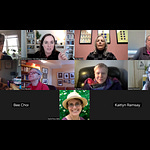Our Pivot Hour this month was a rich, freeform space to tackle some of the challenges and opportunities we face as newsletter creators.
Here are some of the big themes we explored this time:
The Impact of Seasonal Trends on Growth: Addressing how factors like holidays or major events can cause fluctuations in subscriber growth and engagement, and why consistency is key during these times.
Communicating Value for Price Changes: Highlighting strategies for announcing subscription price increases while emphasizing the value you’ve added, creating urgency for readers to lock in the current rate.
Leveraging Complimentary Subscriptions: The thoughtful use of complimentary subscriptions to reward and engage your most loyal supporters and build community behind the paywall.
Effective Lead Magnets for Growth: Strategies for delivering valuable resources to attract new subscribers, like using tools to track downloads and ensure a seamless user experience.
Selling Products Through Substack: Exploring how newsletters can complement offerings like books, emphasizing intentional use of free content to drive interest without giving away too much.
It’s always amazing to see how these conversations evolve.
New to Amanda and The Editing Spectrum?
Welcome! Here, we focus on an iterative newsletter journey, honing key newsletter skills one core theme at a time. Alongside my Editing Spectrum posts and monthly Pivot Hours, I also offer 1:1 support for newsletter creators, helping them strategize and pivot with confidence. Drawing on my expertise in B2C marketing, data analysis and editorial production, I’ll work with you to find your way to connect with and move readers to action. Curious about my impact? Take a look at what others have said about my data audits here.
Complete Summary of Questions and Answers
Converting Free Subscribers to Paid
Question: “The question I had for you was this dilemma I have about converting more free subscribers to paid subscribers or attracting more paid subscribers. I don't offer a service, I offer myself and my writing. The quality and consistency of my writing is strong, but my paid subscriber number has stayed very stagnant for a long time. I've tried writing twice a week, but the data showed me that wasn’t converting anyone. I also made personal voiceovers a paid perk, but that didn’t work either. So, why would anyone go from free to paid if everything is available?”
Answer: “I relate to the instinct to think that I have to add more to what I’m doing to get people to upgrade. But sometimes, adding complexity can steal from our creativity. I recommend getting back to the basics: define where you're taking your readers. What’s the journey from where they are when they find you, to where they’ll end up? That’s your value proposition. Be clear about what free readers get and what paid readers get. And if you’ve added a lot of bells and whistles and they’re not working, stripping back to the basics can be fruitful for both your creativity and your strategy.”
Understanding and Using Data
Question: “I manage a Substack with 20,000 subscribers and about 1,000 paid subscribers. We’ve grown organically without promotions, but now I want to analyze our data. I’m confused about how to track income (numbers in Substack, Stripe, and the bank don’t match), and I also want to figure out what content is working and what’s not. Where should I focus?”
Answer: “Substack’s financial forecasting is pretty much useless—they’re projecting what might come in. Focus on Stripe and what’s hitting your bank account for reliable numbers. To figure out what’s resonating editorially, consider doing a data audit. Look at your high-performing essays and find the themes. For someone your size, I’d recommend a 10x5 audit: analyze your top 10 essays across five categories of reader actions (likes, comments, conversions, etc.). Lastly, check Substack’s retention rate metric—that’s one area where their data is accurate.”
Changing a Newsletter Name
Question: “My newsletter is called Beyond Survival, but I need to change it due to a trademark issue. I’m gutted, but I’d love some guidance on choosing a new name. I’ve brainstormed a shortlist. What should a name do to support my readers?”
Answer: “Start with the journey your readers are on. Where are they when they find you, and where are they going next? A great name captures that. Beyond Survival already suggests a journey beyond trauma, so you have a good instinct for this. Names can be broad or specific—it depends on how tied down you want to feel. Just make sure to check trademarks and URLs to avoid running into issues later.”
Accuracy of Open Rates
Question: “I’ve noticed unusually high open rates, and I think it’s due to Apple’s Mail Privacy Protection. How does Substack account for this?”
Answer: “Substack can’t override what companies like Apple or Gmail are doing to protect user privacy. That’s why open rates are unreliable. I suggest focusing on what Substack can measure accurately, like likes, comments, restacks, and conversions. These actions tell you more about how readers are engaging with your work.”
Should I Use a Paywall?
Question: “I don’t offer workshops or extra services—just my writing. If that’s the case, should I use a paywall, and what’s the best strategy for it?”
Answer: “If you’re not offering extras, an archive paywall is a good option. Consider putting older posts behind a paywall while keeping recent content free. This creates an opportunity for free readers to explore your work, but gives them a reason to upgrade for full access.”
Using Notes for Growth
Question: “What are your thoughts on using Notes for growth, and do you have tips for writing them?”
Answer: “It’s important to be on Notes because Substack is leaning heavily on it for discoverability. That said, Notes can feel like a time suck. Use your activity rating to identify who’s engaging most with your Notes. Focus on being authentic and think about whether you’re more likely to reach free readers or paid subscribers there. That can help you decide what kind of content to share.”
Promotions and Discounts
Question: “I’m thinking about creating a Black Friday offer. I’ve never done a discount before—do you have experience with this? Will it devalue my work?”
Answer: “Discounts don’t have to devalue your work. Think of them as a tool to change someone’s relationship with you. People may hesitate to pay full price if they’re unsure, but a well-timed promotion can nudge them into action. Just avoid extreme discounts—meet readers in the middle with something like an introductory offer.”
Announcing a Price Increase
Question: “I’ve announced a price increase starting in December. How do I encourage free subscribers to lock in the current rate before the change?”
Answer: “Make the price increase the main point of an email. Use a clear, direct headline like Here’s what’s coming in 2025—and why it’s time to lock in your rate. In the email, focus on the value you’ve added and what’s coming next. For newer subscribers, segment them out and frame it as an introduction to everything you’re offering so they understand why the price is going up.”
Offering Comp Subscriptions
Question: “What are your thoughts on offering complimentary subscriptions to some of your best engagers, especially if they’re unlikely to pay?”
Answer: “Comps can be a great way to nurture relationships. Frame it as a gift and explain why you’re inviting them behind the paywall: ‘You’re one of my biggest supporters, and I’d love to see you in this space.’ Mention what they’ll find behind the paywall and how their participation enriches the community.”
Lead Magnets for Newsletter Growth
Question: “I want to offer a free music discovery guide as a lead magnet. Should I deliver it as a private Substack page or an email PDF?”
Answer: “Don’t send it as an email PDF—it’s hard to track downloads. Use a platform like Podia to share it for free while tracking downloads. If you use Substack, make sure the process to access it is easy and clear.”
Seasonal Drops in Substack Traffic
Question: “I used to get one to two new free subscribers a day, but since early October, I haven’t had any. My traffic is steady—could it be seasonal?”
Answer: “Yes, it’s likely seasonal. The U.S. election and holiday distractions can affect behavior. Substack’s algorithm really seemed to shift to prioritize election coverage, which disrupted rhythms for many creators. Stay consistent—things may normalize after the holidays.”
Selling Books Through Substack
Question: “If I teach a skill through a book rather than in emails, should I still use a paywall?”
Answer: “Yes, but you need to be intentional. Use your free posts to introduce the concepts in your book and build interest, but don’t publish the book’s content in your newsletter. Keep the paywall for complementary material or perks.”















Share this post